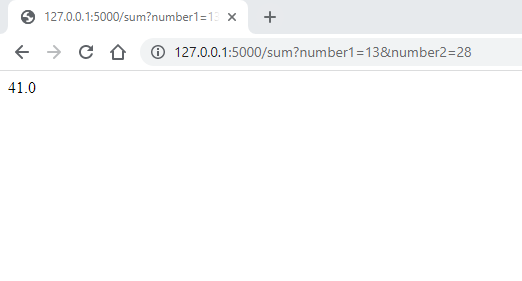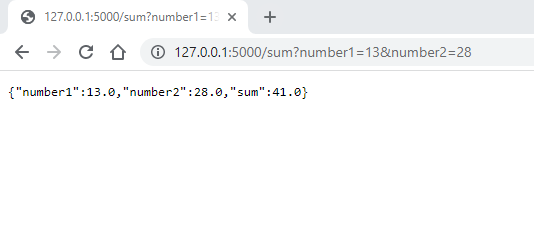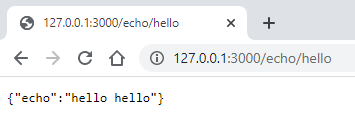python
Setting up a backend service with an interface
In this module you will learn to implement a backend in Python. This way you can build a web service so that the HTML, CSS or JavaScript user interface (UI) communicates with the HTTP endpoints provided by the backend written in Python.
The user of a backend does not necessarily have to be a browser. With the approach presented here, the backend service can be used programmatically from any service with any programming language thanks to the HTTP connection protocol.
Flask library installation
A Python program is made into a backend service using the Flask library. Flask enables the programming of endpoints. An external program (such as a web browser) can use those endpoints to execute operations programmed into the backend service.
Let’s look at an example where we create a backend service that receives two numbers and adds them together. This kind of an operation would not of course need a backend service. However, this simple example is used just to demonstrate the required technology.
We will start by installing the Flask library. The installation can be done directly from the PyCharm IDE:
- Select View / Tool Windows / Python Packages.
- Type Flask into the search field. Select Flask from the list that opens and click Install
The library is now ready to use.
Programming endpoints
Once Flask has been installed, we can write the first version of our program into a file named sum_service.py:
from flask import Flask, request
app = Flask(__name__)
@app.route('/sum')
def calculate_sum():
args = request.args
number1 = float(args.get("number1"))
number2 = float(args.get("number2"))
total_sum = number1+number2
return str(total_sum)
if __name__ == '__main__':
app.run(use_reloader=True, host='127.0.0.1', port=5000)
Let’s see how the program works by starting from the last line. The call to the app.run method launches the backend service.
The service is opened in IP address 127.0.0.1 which is a so-called loopback (or localhost) address that points to the IP address
of your own computer. This means that the connection to that IP address can only be established from the same computer where the
program is running. Port number 5000 tells that the backend server listens to port 5000 for communication from the same
computer.
Line @app.route('sum') defines a so called endpoint. It means that the function calculate_sum on the next line is executed when
a user of the backend sends a request to the IP address followed by the string /sum. This means that the function can be
called from the browser by typing http://127.0.0.1:5000/sum as the web address. Technically, the browser then sends an
HTTP protocol GET request that the backend service built with Flask responds to.
The request portrayed above is not yet enough to calculate the sum, as also the numbers for calculating the sum must be defined
in the request. The numbers can be passed as parameters of the GET request and then be processed using the args.get method of the
request library.
This way the backend service could be called by writing for example the address http://127.0.0.1:5000/sum?number1=13&number2=28 to
a browser. The first parameter that has been converted to a float “13” is assigned as the value of the number1 variable. Respectively,
the second parameter, string “28”, is converted to a float and assigned to the number2 variable. The sum is calculated, converted into
a string and then returned as the return value of the function.
When the backend service is called from a browser the resulting number is seen on the browser window:

At this point the backend service technically works, but the format of the result is not optimal to be processed programmatically.
Generating a JSON response
When a backend sends a response to a browser, the best format for the response is usually JSON. JSON (JavaScript Object Notation) is a presentation format that complies with the structure of JavaScript objects. Luckily, the structure is also intuitive for developers accustomed to objects in Python language.
Let’s modify the sum function in the example so that it no longer returns a string but instead produces a response in JSON format.
This will be done automatically from the Python dictionary structure:
from flask import Flask, request
app = Flask(__name__)
@app.route('/sum')
def calculate_sum():
args = request.args
number1 = float(args.get("number1"))
number2 = float(args.get("number2"))
total_sum = number1+number2
response = {
"number1" : number1,
"number2" : number2,
"total_sum" : total_sum
}
return response
if __name__ == '__main__':
app.run(use_reloader=True, host='127.0.0.1', port=5000)
Now the program produces a JSON response which is easy to process for example by running a JavaScript code on a browser:

The simple backend service presented here can be used to build a more versatile backend service with the required amount of endpoints.
Parsing the request
In the previous examples, the parameter values were provided as HTTP request parameters, separated from the domain and country parts
with a question mark (?). This is a traditional way to send parameters in HTTP requests.
An alternative way is to specify the resource targeted by the request in the body of the web address. The following simple example implements an “echo service” that echoes, or doubles, the string provided by the client. In the example, the string is not given as a parameter but as a part of the actual web address. Flask provides an easy approach for handling parts of the web address:
from flask import Flask
app = Flask(__name__)
@app.route('/echo/<text>')
def echo(text):
response = {
"echo" : text + " " + text
}
return response
if __name__ == '__main__':
app.run(use_reloader=True, host='127.0.0.1', port=3000)
The service looks like this when viewed via a web browser:

The developer of the backend service can freely choose how the handling of the web address part after the domain and the country code is done. Particularly, the REST architecture style encourages the latter approach where the targeted resource is given as part of the actual web address instead of providing it as a parameter value.
Error handling
Let’s return to the earlier example on calculating the sum of two numbers. We assume that the program
has been amended so that the two numbers are provided as part of the body of the web address. Thus,
a valid request looks like this: http://127.0.0.1:3000/sum/42/117.
In the earlier example, we assumed that the request is always error-free.
However, at least the following errors are possible and should be dealt with:
- The user tries to call an erroneous endpoint:
http://127.0.0.1:3000/dum/42/117 - A correct endpoint is called, but the sum cannot be computed because of an invalid number as input:
http://127.0.0.1:3000/sum/4t23/117
In the first case, the Flask backend service automatically returns the error code 404 (Not found). In the latter case, the status code 500 (Internal server error) is returned. The originator of the request can handle the error situations programmatically. However, as the authors of the backend service, we have the option to handle the error situations as they emerge, producing the request sender more detailed information about the potential cause of the error.
The following program handles the error situations in a more elegant fashion:
- A request to an invalid endpoint produces the status code 404 with a JSON response:
{"status": 404, "message": "Invalid endpoint"}. - Should the conversion of a parameter to float type fail, the following JSON is sent:
{"status": 400, "teksti": "Invalid number as addend"}. The backend service now returns the more suitable HTTP status code 400 (Bad Request) instead of the default code 500 (Internal server error).
Also, the program adds the status code to the body of the JSON response. The code in the body is sent just as
additional information for the client. The ‘real’ HTTP status code is provided as the statuscode parameter
of the Response object. (The Response object must be created whenever we want to send something else than the JSON auto-converted
from the dictionary accompanied with the default error code 200 (OK).
Unfortunately, we cannot take advantage of the dictionary-to-JSON auto-conversion in this case, but
we must use the json.dumps method instead.).
As the Response object is created, we need to specify the so-called MIME type. A MIME type tells the client
how the content should be interpreted. In this case, the MIME type is set to "application/json".
The expanded program is as follows:
import json
from flask import Flask, Response
app = Flask(__name__)
@app.route('/sum/<number1>/<number2>')
def calculate_sum(number1, number2):
try:
number1 = float(number1)
number2 = float(number2)
total_sum = number1+number2
response = {
"number1" : number1,
"number2" : number2,
"total_sum" : total_sum,
"status" : 200
}
return response
except ValueError:
response = {
"message": "Invalid number as addend",
"status": 400
}
json_response = json.dumps(response)
http_response = Response(response=json_response, status=400, mimetype="application/json")
return http_response
@app.errorhandler(404)
def page_not_found(error_code):
response = {
"message": "Invalid endpoint",
"status": 404
}
json_response = json.dumps(response)
http_response = Response(response=json_response, status=404, mimetype="application/json")
return http_response
if __name__ == '__main__':
app.run(use_reloader=True, host='127.0.0.1', port=5000)